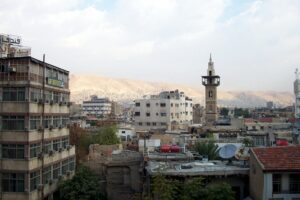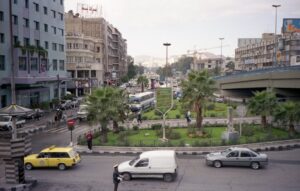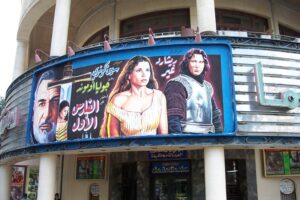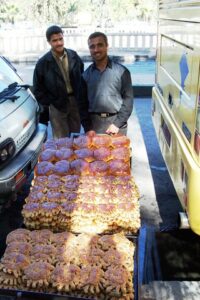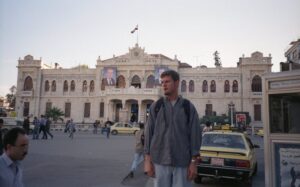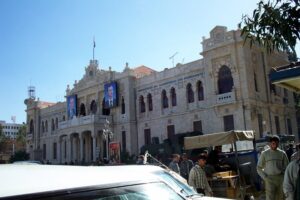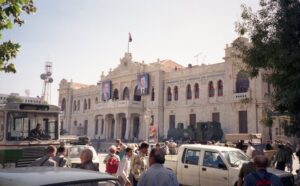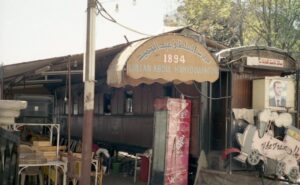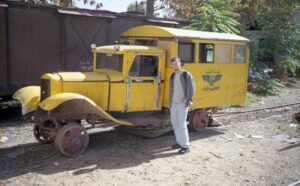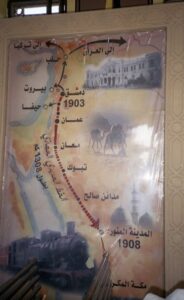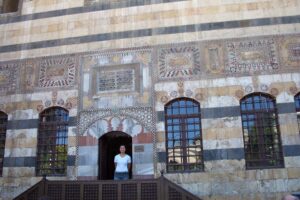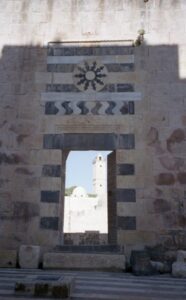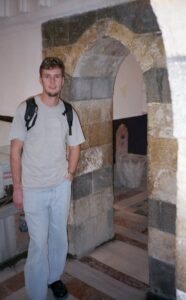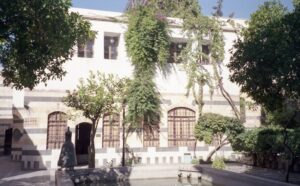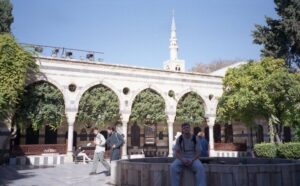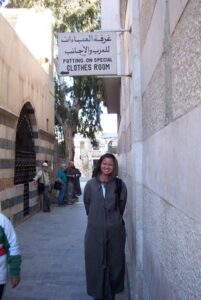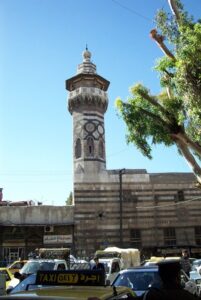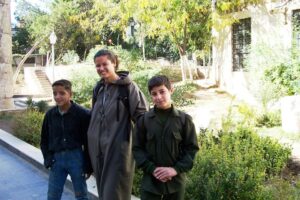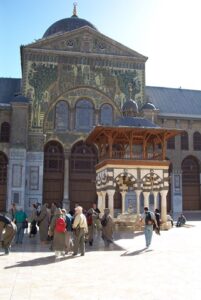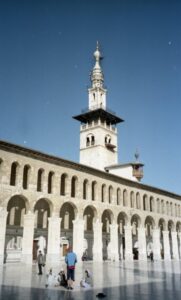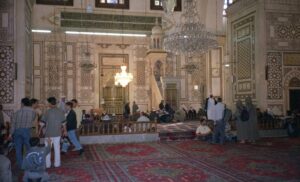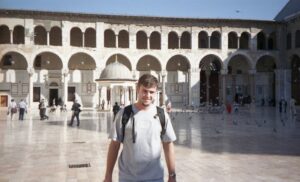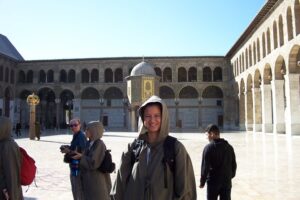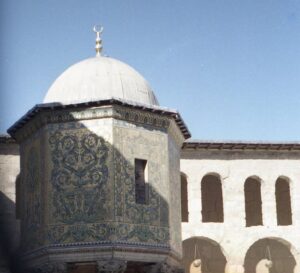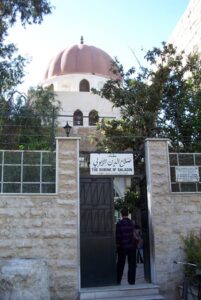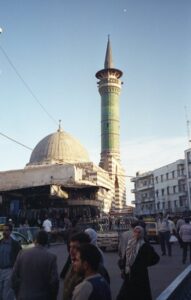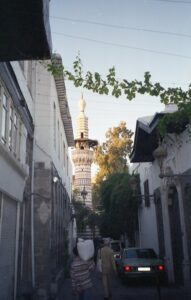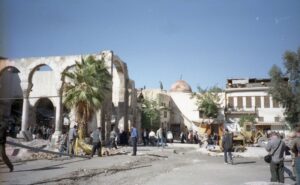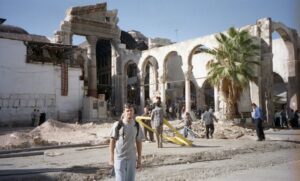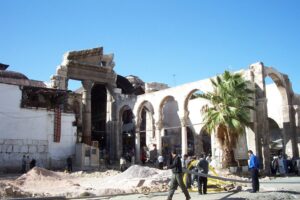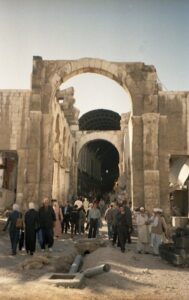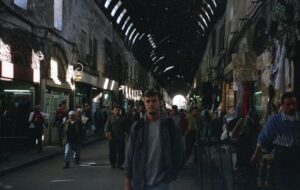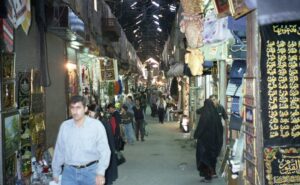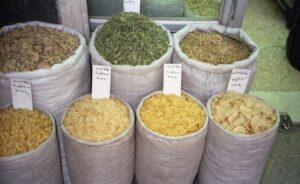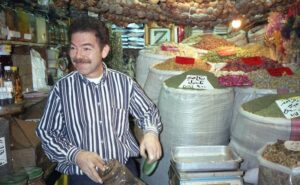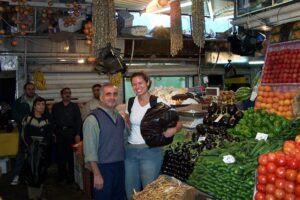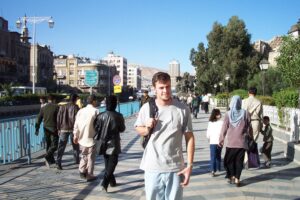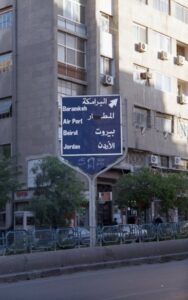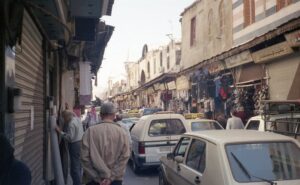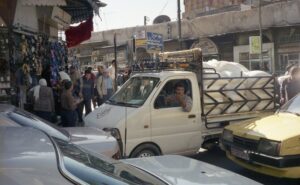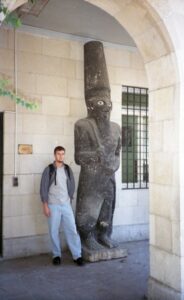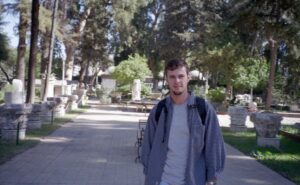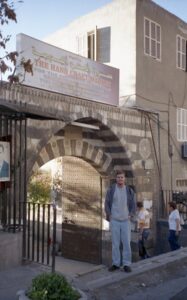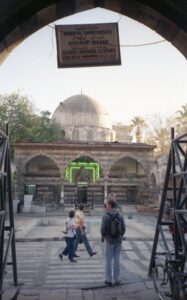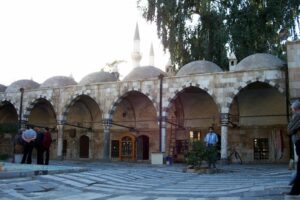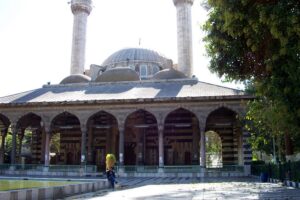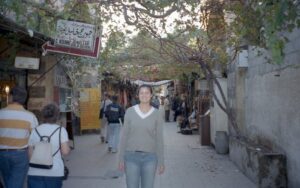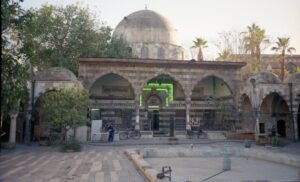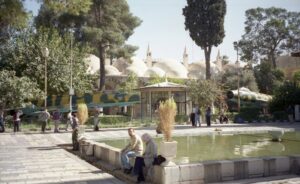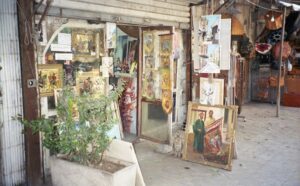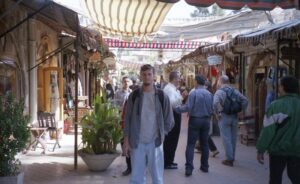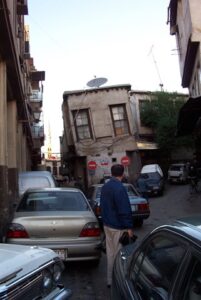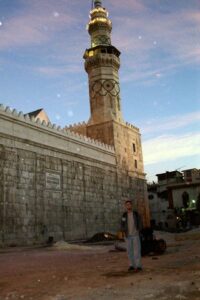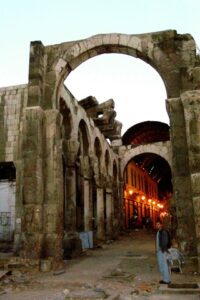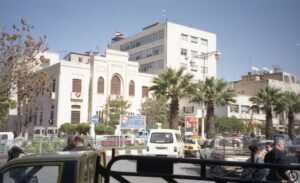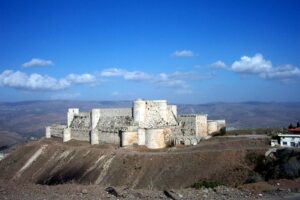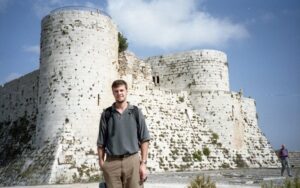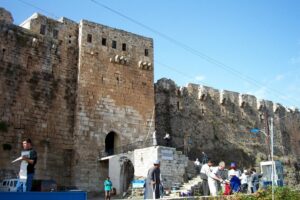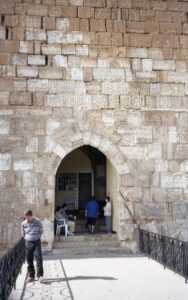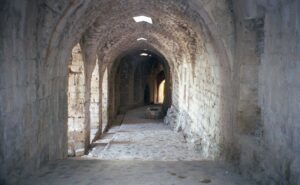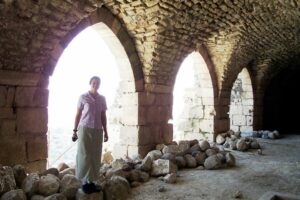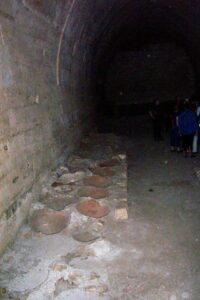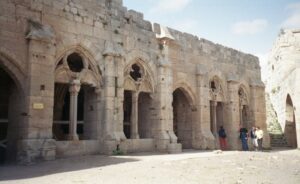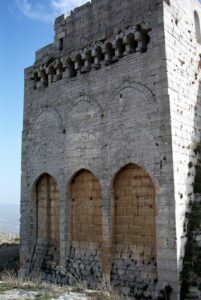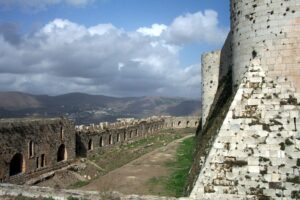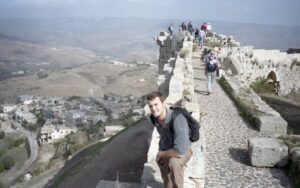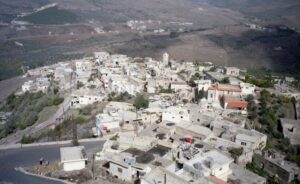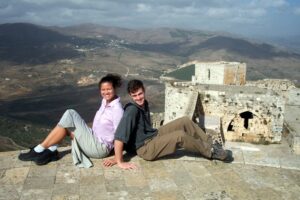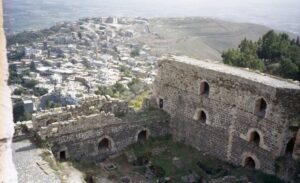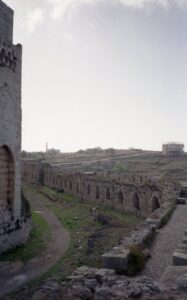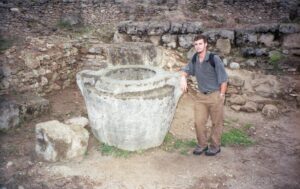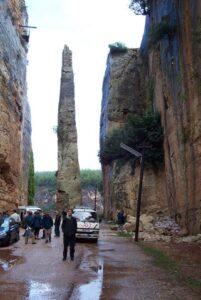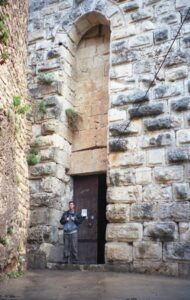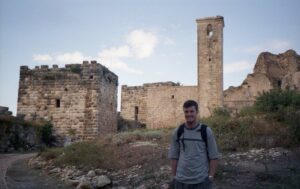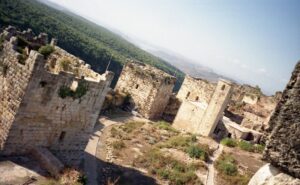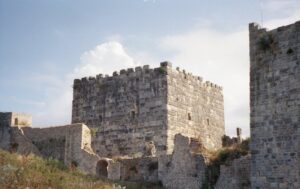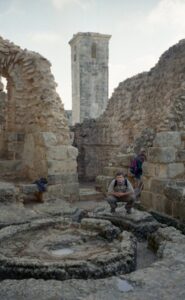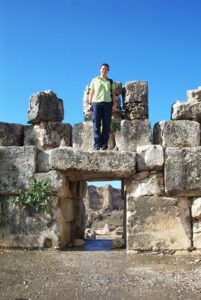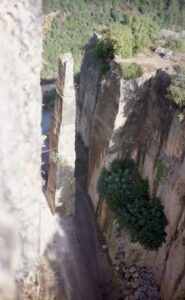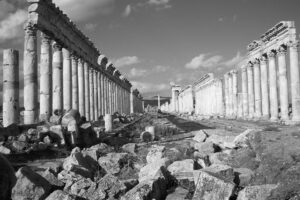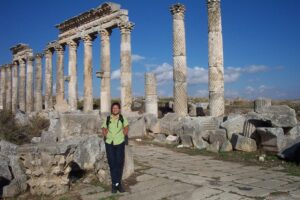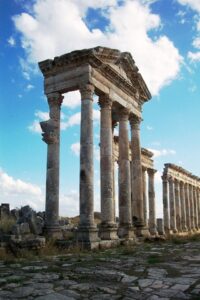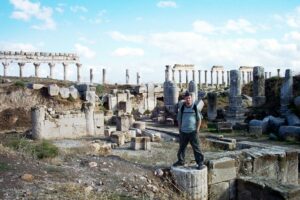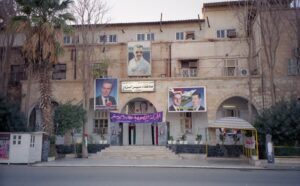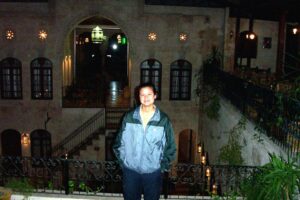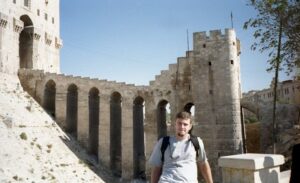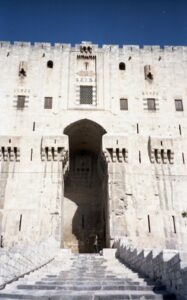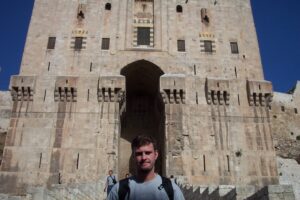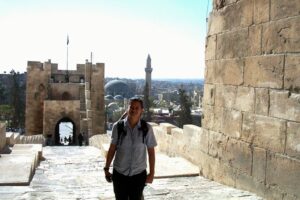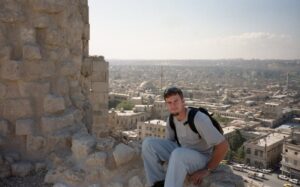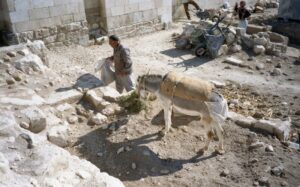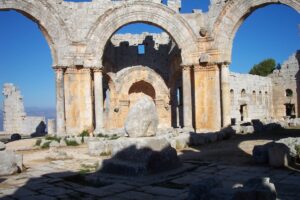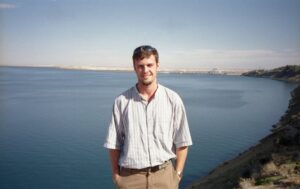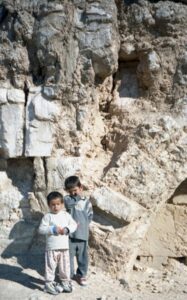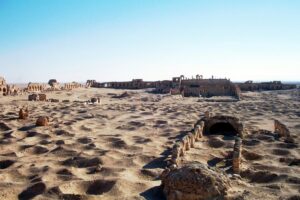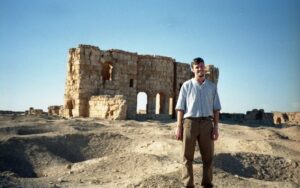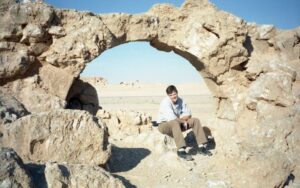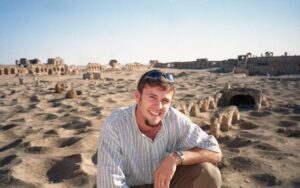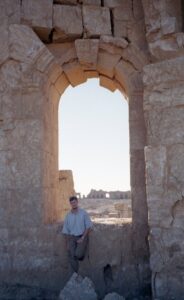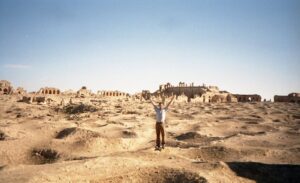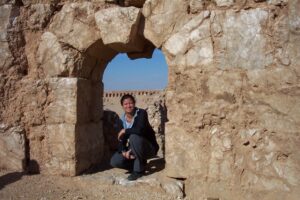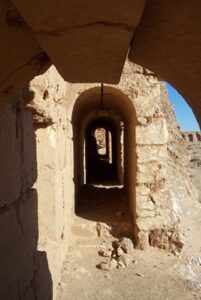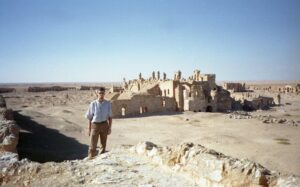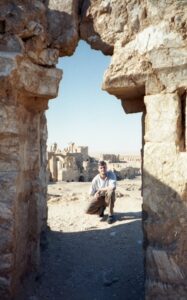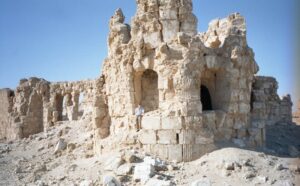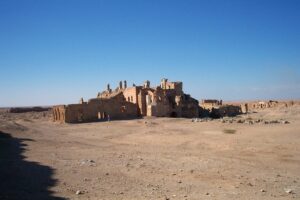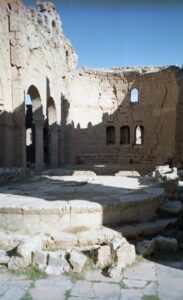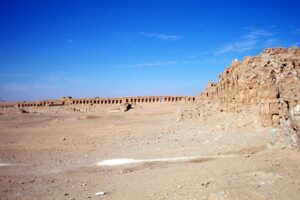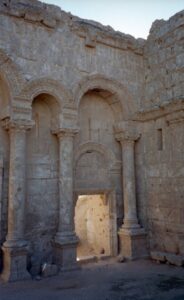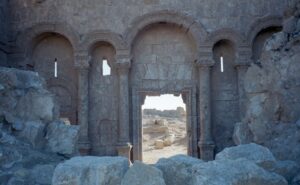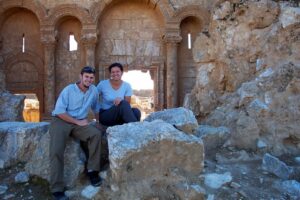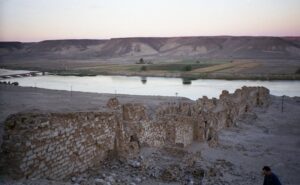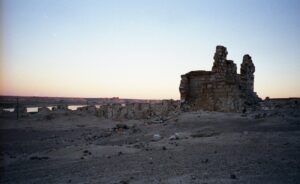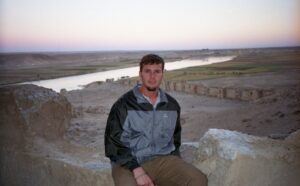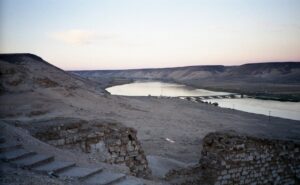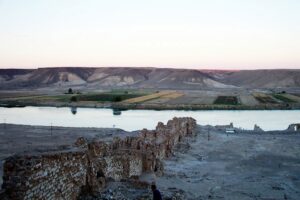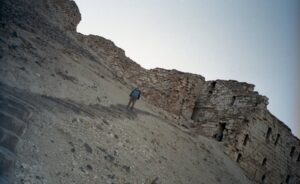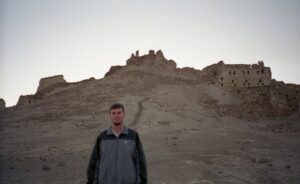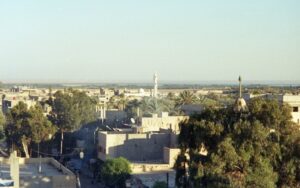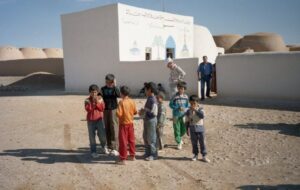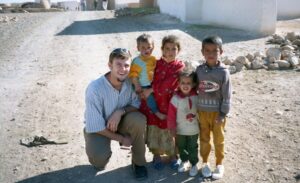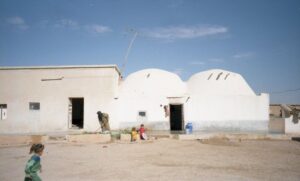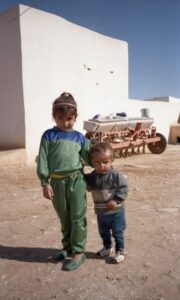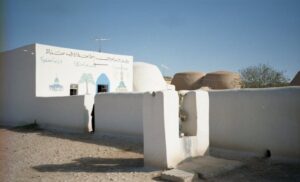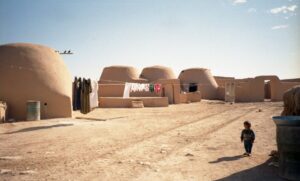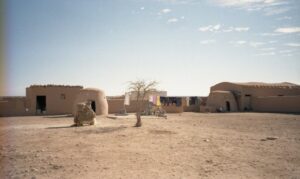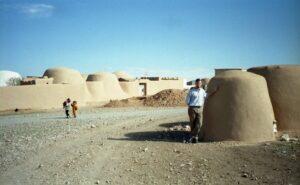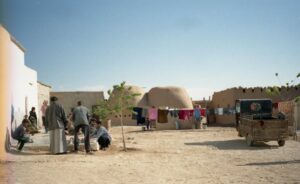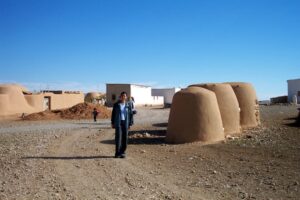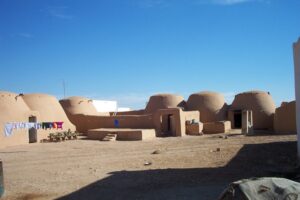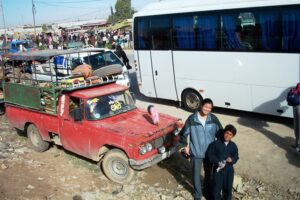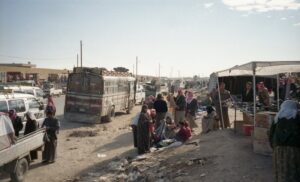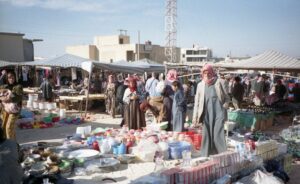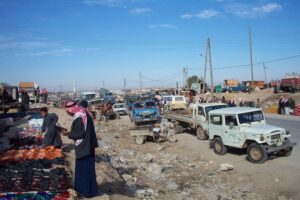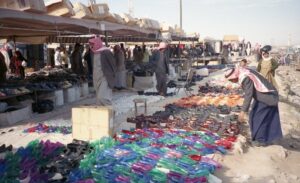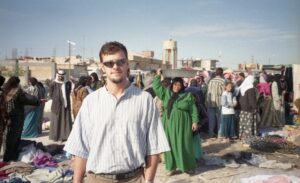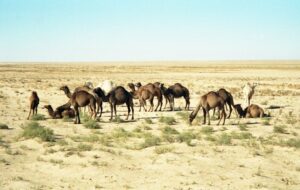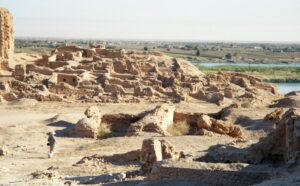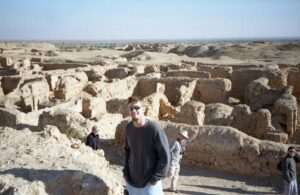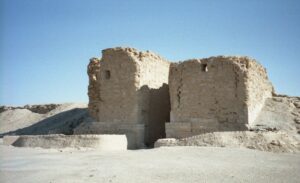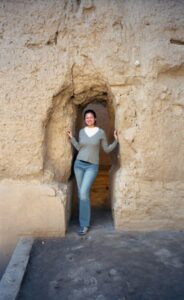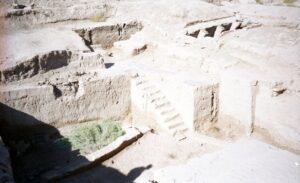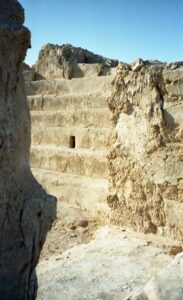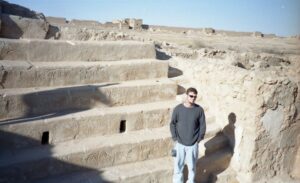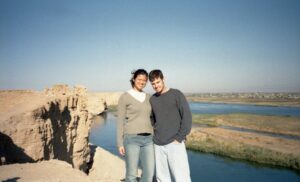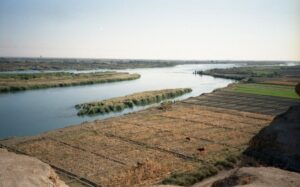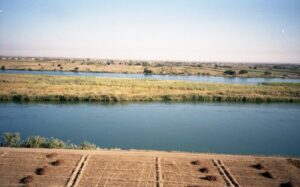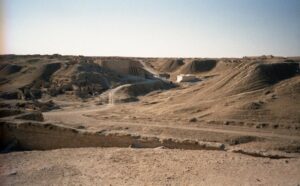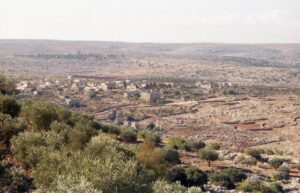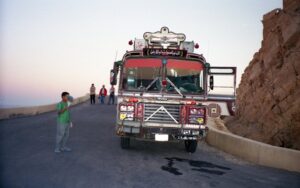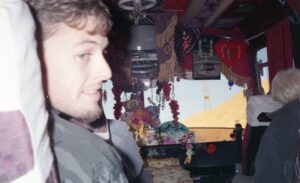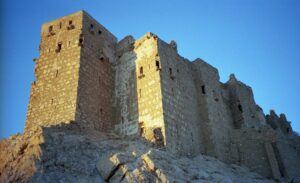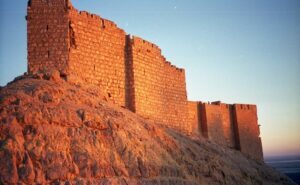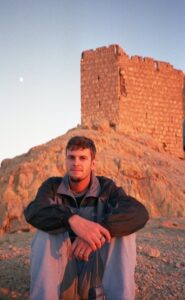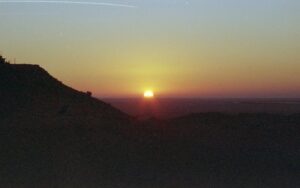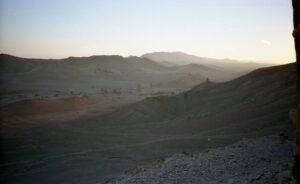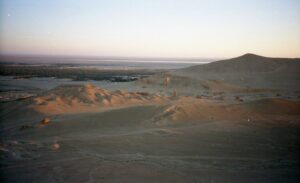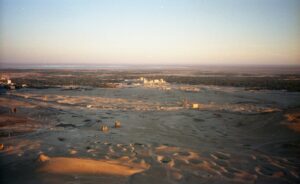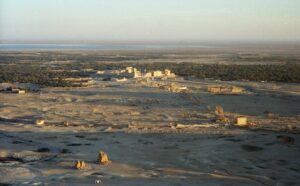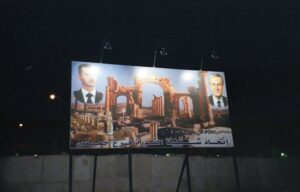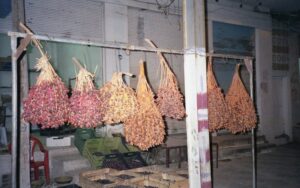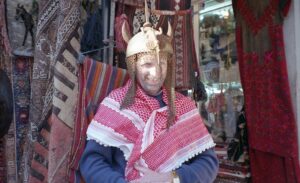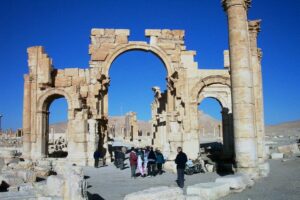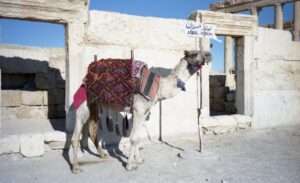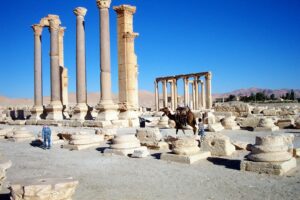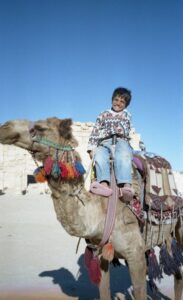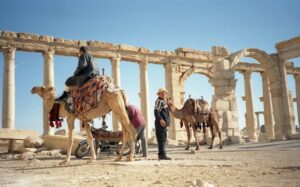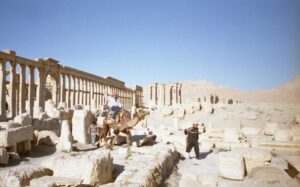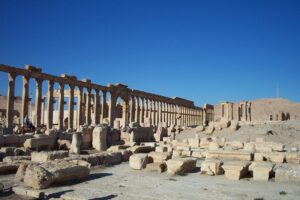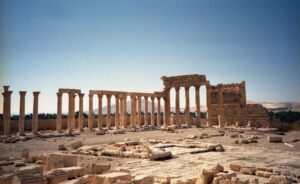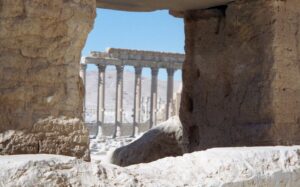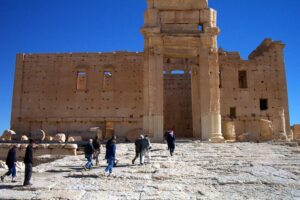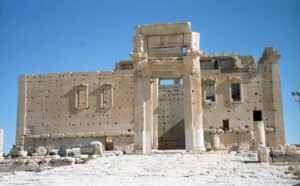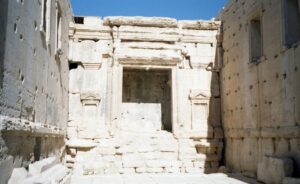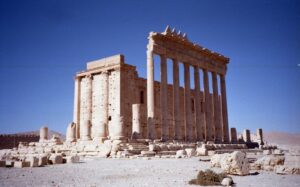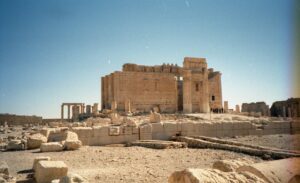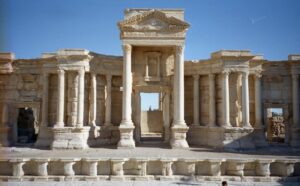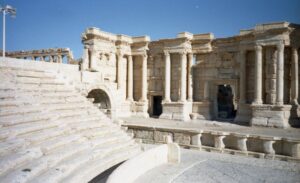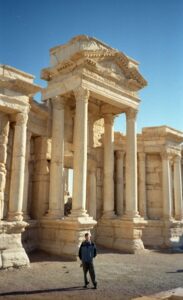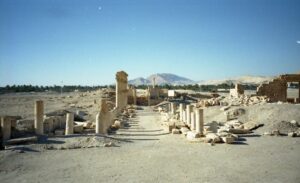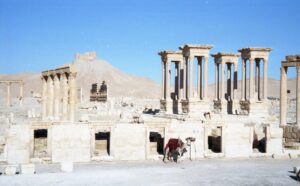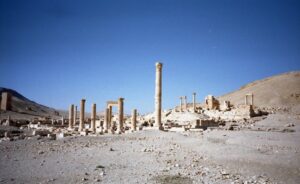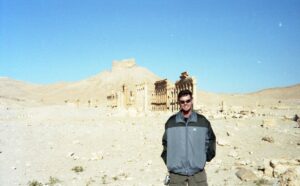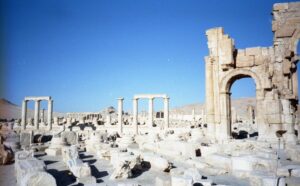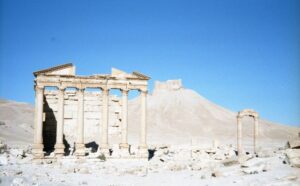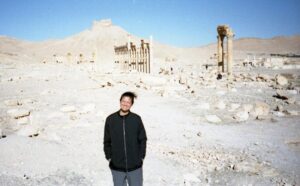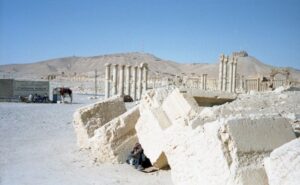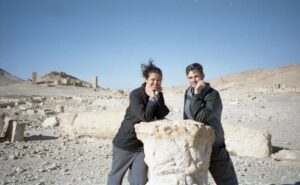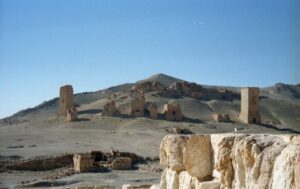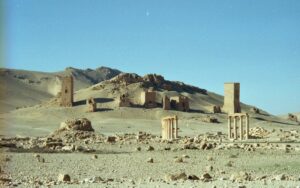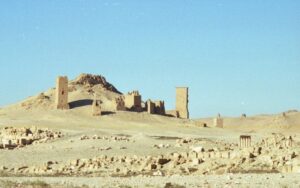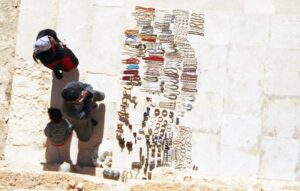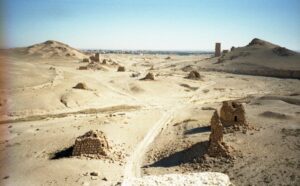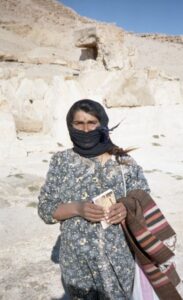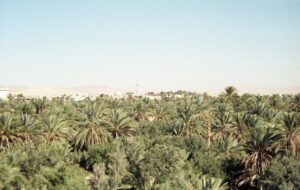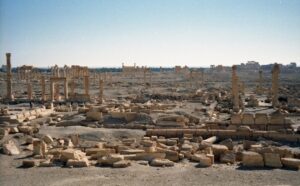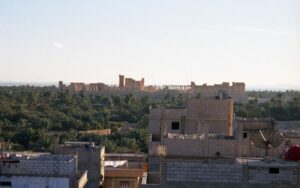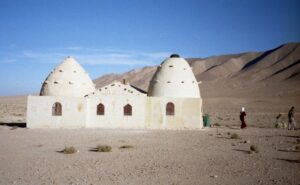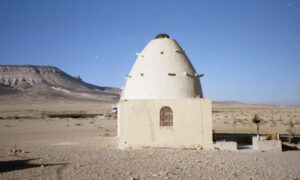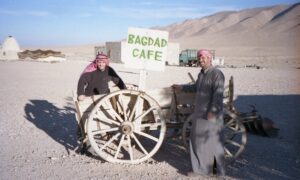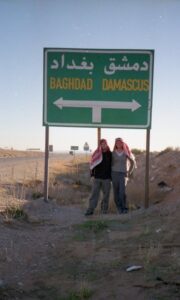Syria has a bad rap. Our friends gazed at us in horror when we told them we were choosing Syria as a vacation destination. Condolences were handed out as if we were going to be attending our own funeral, “So sorry to hear about your trip, when do you *think* you’ll be back?” We couldn’t shake off the stereotypes prior to the trip but upon return, we immediately made it our mission to tell everyone how wonderful Syria is. The cities of Aleppo and Palmyra are top notch and should not be missed. A visit to the local hammam to get scrubbed, pummeled, rinsed and massaged is a unique experience everyone should have at least once. Unlike Egypt, we were never hassled in Syria and really enjoyed our experiences there.
![]()
The rather drab Damascus city skyline (as seen from our hotel)
![]()
View of Damascus from our hotel room
![]()
Arabic billboard for the movie "First Knight"; Damascus
![]()
Sugary treats for sale, Damascus street vendors
![]()
Robby standing in front of the Al Hijaz train station. The Ottoman railway network linked Istanbul to Damascus and onward to Medina
![]()
Al Hijaz train station, Damascus
![]()
Busy street scene in front of the Al Hejaz railway station in Damascus
![]()
Train shed at Al Hejaz railway station. Note the 1894 Sultan Abdul Hamid II's wagon, Damascus
![]()
Robby next to a decommissioned train carriage at the Damascus Al Hejaz railway station
![]()
Map showcasing the ambitious plan of the Ottoman Railway, which was to link Istanbul (Turkey) to Mecca (Saudi Arabia) via Damascus (Syria). The railway only got as far as Medina because the project was abandoned during WWI; Al Hejaz railway station in Damascus
![]()
Becky stands inside the 18th century Al Azem Palace, Damascus
![]()
Portal in Al Azem Palace, Damascus. Note the materials used: limestone, sandstone, basalt and marble
![]()
The royal shitter, Al Azem Palace, Damascus
![]()
Robby sitting on a water fountain at Al Azem Palace, Damascus
![]()
Becky at the "Putting on special clothes room" where she donned a robe to cover up, Umayyad Mosque (Great Mosque of Damascus)
![]()
The circa 1488 octagon shaped Minaret of Qaitbay, the west minaret of Umayyad Mosque
![]()
Two Syrian boys get a kick out of seeing Becky covered up at the Umayyad Mosque, Damascus
![]()
Courtyard view of the circa 705 AD Umayyad Mosque
![]()
View of the minaret of the bride, which was the first minaret built for the Umayyad Mosque
![]()
Interior view of Umayyad Mosque's prayer hall, Damascus
![]()
Robby standing in front of the Dome of the Clock, Umayyad Mosque (one of the oldest and largest mosques in the world)
![]()
Becky at Umayyad Mosque, Damascus
![]()
This octagonal structure is known as the "Dome of the Treasury". Decorated with 14th century mosaics, the mosque's funds were stored here; Great Mosque of Damascus (Umayyad Mosque)
![]()
Entrance to the Shrine of Sala ad-Din, located in the northwest corner of Damascus' Umayyad Mosque
![]()
Mosques are a common sight in busy Damascus
![]()
Gorgeous minarets abound in old Damascus
![]()
Construction work going on at the Temple of Jupiter (built by the Romans during the rule of Augustus), Damascus
![]()
Robby in front of the Temple of Jupiter in old Damascus
![]()
Temple of Jupiter gateway to Al-Hamidiyah Souq, Damascus
![]()
Temple of Jupiter leading to the entrance of Al Hamidiyah Souq, Damascus
![]()
Robby inside Al Hamidiyah Souq, Damascus
![]()
Al-Hamidiyah Souq is the largest souk in Syria and definitely worth a stroll, Damascus
![]()
Pasta, grains, herbs and beans for sale; Al-Hamidiyah Souq
![]()
Friendly spice seller at the Hammadiyeh (Hamidiyah) Bazaar, Damascus
![]()
Becky meets a friendly vegetable vendor; Damascus
![]()
Robby on the busy streets of Damascus
![]()
Busy Damascus street scene
![]()
A Syrian claps his approval upon seeing our group exploring Damascus
![]()
Robby poses next to an Assyrian statue at the National Museum entrance; Damascus
![]()
In the garden of the National Museum, Damascus
![]()
Robby at the entrance to the Hand Craft Market located in Tekieh Sulaimanieh, Damascus
![]()
Robby standing in the courtyard of the Tekkiye Madrasa, Damascus
![]()
Arcades and domes of the madrassa, Takiyya al-Sulaymaniyya; Damascus
![]()
View of the 1516 Sultan Selim mosque (also known as the Tekkiye Mosque Madrasa), Damascus
![]()
Becky enjoying the hand craft souq of Damascus
![]()
The Tekkiye Mosque Madrasa, built by Turkish architect Sinan in 1560 for Selim II, Damascus
![]()
Fighter jets on display outside the Tekkiye Suleymaniye's arcaded cells, Damascus
![]()
Souvenirs on display at the hand craft souq; Tekieh Sulaimanieh, Damascus
![]()
Finding no bargains at the Hand Craft Souq, Damascus
![]()
Crooked house in old Damascus
![]()
Robby next to the Umayyad Mosque at sunset during our walk about old Damascus
![]()
Next on our Damascus walking tour was a stroll through the Temple of Jupiter into Al-Hamidiyah Souq
![]()
Chaotic traffic in Damascus!
![]()
View of Krak Des Chevaliers, a crusader castle considered one of the premier medieval castles in the world
![]()
Robby in front of Krak des Chevaliers, quite possibly the best preserved Crusader Castle in the Middle East!
![]()
Entrance to Krak des Chevaliers crusader castle
![]()
Entrance to Krak des Chevaliers. Notice the Arabic script etched into the bricks above the entrance
![]()
Exploring the long dark passages in the heart of the castle, Krak des Chevaliers
![]()
Becky standing in the archway of the Warehouse and Armory; Krak des Chevaliers
![]()
Remains of storage containers, Krak des Chevaliers
![]()
Hall of Knights, Krak des Chevaliers
![]()
Tower of the Daughter of the King, Krak des Chevaliers
![]()
View of Krak des Chevaliers, built by the crusaders Knights Hospitaller
![]()
Enjoying the vistas from Krak des Chevaliers
![]()
The village al-Husn below Krak des Chevaliers
![]()
Striking a pose at Krak des Chevaliers, a UNESCO world heritage site
![]()
Krak des Chevaliers' dramatic setting atop Jebel Khalil
![]()
Krak des Chevaliers was built as a concentric castle, with narrow outer walls
![]()
Robby at Krak de Chevaliers, one of the best preserved medieval castles in the world
![]()
This hand carved 28m deep ditch was created by the Byzantines at the Citadel of Salah Ed-Din (Qal'at Salah al-Din). The needle tower behind Becky supported a drawbridge into the crusader castle
![]()
Robby beneath the entrance to the crusader castle at Salah Ed-Din, one of the very few castles not entrusted to the military orders of the Hospitaller or Templars
![]()
Robby at the Citadel of Salah Ed-Din
![]()
View of the towers and wall of Salah Ed-Din Citadel
![img428]()
Fortified since the 10th century, the Citadel of Salah Ed-Din enjoys UNESCO world heritage status
![]()
Robby posing at Saladin Castle (also known as Citadel of Salah Ed-Din)
![]()
Becky at Qal'at Salah El-Din
![]()
The Citadel of Salah Ed-Din is an architectural masterpiece. The 28m Byzantine ditch was carved out of solid rock! The 100m ditch runs along the east side of the citadel, with a solitary 28 meter needle allowing access to the castle via drawbridge...simply phenomenal!
![]()
The beautiful Cardo Maxima of Apamea
![]()
Becky strikes a pose in front of the colonnade of Apamea
![]()
Gray granite columns, Al-Ghab plain, Apamea
![]()
Robby posing on top of a column in Apamea
![]()
Posters of Hafez al-Assad (who died in 2000) and his son President Bashar al-Assad
![]()
Becky standing on the balcony of our posh Aleppo hotel
![]()
Robby below the entrance ramp leading up to Aleppo's citadel
![]()
Imposing entrance to the Aleppo Citadel
![]()
Robby at the 12th century fortified gate of Aleppo's citadel
![]()
View of Becky and Aleppo, as seen from the entrance to the Citadel
![]()
Robby admiring the vista of Aleppo from the citadel, considered one of the oldest and largest castles in the world
![]()
Renovation work at the Aleppo citadel
![]()
View of the famous pillar that St. Simeon supposedly sat atop for 36 years, Daret' Azze
![]()
Robby in front of Euphrates Dam (also known as Tabqa Dam), which holds back Lake Assad, Syria's largest lake
![]()
These two shy boys greeted us as we explored the ancient city of Resafa
![]()
The now ruined city of Resafa flourished in its heyday, serving as as a major stop on the caravan routes linking Palmyra, Aleppo & Dura Europos
![]()
Robby smiling at Resafa (known in Roman times as Sergiopolis)
![]()
Robby under one of Resafa's many arches
![]()
Striking a pose in the ruins of Resafa
![]()
Resafa flourished despite being a desert outpost because it was on the caravan routes linking the cities of Aleppo, Dura Europos and Palmyra
![]()
We learned that this Roman outpost (dating from 9th century BC) became a pilgrimage town for Christians in the 4th century. They were coming for Sergius, a Roman soldier martyred in Resafa
![]()
Becky crouches in the Resafa ruins
![]()
View down the covered archway tunnel which was built right up against the perimeter wall; Resafa
![]()
Robby enjoying having the archaeological site of Resafa all to himself!
![]()
Plenty of time to photograph the amazing ruins of Resafa
![]()
Robby is dwarfed by the massive ruins of Resafa
![]()
View of St. Sergius Basilica complex in Resafa, a Syrian ghost town
![]()
Basilica of Saint Sergius; Resafa
![]()
View of Resafa ruins, the walls of which are over 1600 feet in length and 1100 feet in width
![]()
Detail of the north entrance of Resafa
![]()
Another view of Resafa's north gate, made entirely out of white gypsum stone
![]()
Posing in front of the north gate of the city of Resafa
![]()
The ancient city of Halabiye was built in the 3rd Century by Queen Zenobia (queen of Palmyra). The fortress was protected by massive city walls such as this one leading down to the Euphrates
![]()
Dusk view of the citadel of Halabiye
![]()
Robby watching the sun set over the Euphrates from the Fortress of Halabiye
![]()
View from Halabiye Citadel
![]()
View of the Euphrates River at sunset, as seen from Halabiye Fortress
![]()
Robby heading down from Halabiye Fortress
![]()
Robby grins after his visit to Halabiye Fortress
![]()
Deir ez-Zor skyline as seen from our hotel on the left bank of the Euphrates
![]()
Schoolboys bashfully check us out at the adobe beehive village
![]()
Robby posing with several children of the adobe beehive village we visited
![]()
Daily life in the beehive village
![]()
Cute kids pose for a photo, beehive village
![]()
Exterior of the school in the beehive village we visited
![]()
Little boy wandering by himself in the beehive village
![]()
Beehive villages (built entirely out of mud brick) are ideally suited for the desert environment
![]()
Robby posing next to the beehive village we stopped at
![]()
Parting view of our beehive village
![]()
Becky at an adobe beehive village
![]()
Mud built beehive village, Halabiyyeh suburbs
![]()
Becky and a friendly boy; roadside market somewhere between Halabiyyeh to Mari
![]()
Busy street scene, somewhere in Syria
![]()
Street scene on market day
![]()
Jelly shoes for sale at a roadside market
![]()
Robby at an impromptu roadside stop we made
![]()
Our first glimpse of wild camels in the Syrian desert!
![]()
Dura Europos is a ruined walled city built on a cliff 90 meters above the Euphrates River
![]()
Palmyra Gate (as seen from the west outside the gate), Dura Europos, 2nd century BC
![]()
Becky in an arch at Dura Europos
![]()
Dura Europos was once referred to as the "Pompeii of the Syrian desert" due to its amazing preservation. After it was abandoned in 257 AD, the city was covered by mud and sand and remained largely intact over the centuries
![]()
Another view of the Temple of Artemis, Dura Europos
![]()
Robby at the Temple of Artemis, Dura Europos
![]()
Posing at the edge of Dura Europos
![]()
Overlooking the Euphrates River from Dura Europos
![]()
View of the Euphrates from Dura Europos, located on an escarpment above the river
![]()
Another view of Dura Europos
![]()
Surprisingly, the Syrian countryside isn't all desert!
![]()
To get to Fakhr-al-Din al-Ma'ani Castle, we had to ride local transport up the steep hill side; Palmyra
![]()
Robby in our local mini bus ride up to Fakhr-al-Din al-Ma'ani Castle, Palmyra
![]()
Fakhr-al-Din al-Ma'ani Castle was built by the Mamluks in the 13th century
![]()
Sunset at Fakhr-al-Din al-Ma'ani Castle, Palmyra
![]()
Robby enjoying the view overlooking Palmyra at Fakhr-al-Din al-Ma'ani Castle
![]()
We were happy to get a chance to see the sun set from Fakhr-al-Din al-Ma'ani Castle, which seems to be a rite of passage for all Palmyra visitors
![]()
Peaceful scene of Palmyra after sunset
![]()
One final view of Palmyra during sunset
![]()
Sunset view over Palmyra, the once thriving city and vital caravan stop for travelers making their journey across the Syrian desert
![]()
Amazing view of Palmyra as seen from the Fakhr ud-Din Castle
![]()
Night shot of a billboard showcasing President Bashar al-Assad along with his father Hafez al-Assad endorsing the ancient city of Palmyra
![]()
Dates for sale in Palmyra. The name of the city comes from the Latin word "palma", meaning palm, in reference to the city's many palm trees. Thus we simply had to buy some dates while here!
![]()
Trying on some souvenirs for size; Palmyra
![]()
The ruins of Palmyra are a highlight of any visit to Syria. Here, our group stands beneath Palmyra's 1800 year old Arch of Triumph
![]()
Enjoy a camel ride of the ruins, a quintessential experience of Palmyra
![]()
Wherever there are tourists, there will be camel drivers looking for potential customers; Palmyra
![]()
An adorable Syrian boy tries to convince us to go for a whirl; Palmyra
![]()
Thankfully, there isn't too much pressure for a camel ride through Palmyra!
![]()
A member of our group succumbs to the pressure and rides off on a camel to explore Palmyra
![]()
The colonnade of the Decumanus, Palmyra
![]()
Another view of the colonnade of Palmyra
![]()
Entering the Temple of Bel (also known as Temple of Ba'al), one of the best preserved ruins in Palmyra
![]()
The great temple of Ba'al (Bel) was considered one of the most important religious structures in the 1st century AD
![]()
Temple of Bel (interior of cella, view to the north); Palmyra
![]()
Temple of Bel, cella and columns; Palmyra
![]()
Yet another view of the wonderfully preserved Temple of Bel; Palmyra
![]()
View of the Roman Theater's stage; Palmyra
![]()
Palmyra's Roman Theater dates back to the second-century CE
![]()
Robby on the stage of the Roman Theater; Palmyra
![]()
The ancient city of Palmyra was mentioned in the Old Testament as being fortified by Soloman (just to give some perspective on how old this fascinating desert city is!)
![]()
The tetrapylon (an ancient Roman monument of cubic shape) on the Cardo Maximus with Fakhr-al-Din al-Maani Castle dominating the hill in the background
![]()
The Temple of the Standards; Palmyra
![]()
Robby standing in front of the columns of the inner court of the Temple of Ba'al with the 13th century Fakhr-al-Din al-Ma'ani Castle, sometimes also referred to as "Qala'at ibn Maan" dominating the hilltop behind
![]()
View of Palmyra as seen from the Arch of Triumph
![]()
The Funerary Temple no. 86 (also known as the House Tomb) in Palmyra
![]()
Becky strikes a pose in stunning Palmyra
![]()
A local tries to find some shade under the massive ruins of Palmyra during the mid-day sun
![]()
Our Valley of the Tombs pose; Palmyra
![]()
Palmyra's Valley of the Tombs
![]()
One final glimpse of the Valley of the Tombs; Palmyra
![]()
Roman era funerary towers located in the "Valley of the Tombs". They are multi-story sandstone monuments designed to accommodate hundreds of sarcophagi; Palmyra
![]()
Jewelry for sale at the Valley of the Tombs; Palmyra
![]()
Another view of the Valley of the Tombs; Palmyra
![]()
A friendly Bedouin woman; Palmyra
![]()
Palmyra is an ancient oasis city (as evidenced by the numerous palm trees). The modern city of Tadmur is off in the distance
![]()
The sprawling ruins of ancient Palmyra
![]()
View of the ancient Roman city and oasis of Palmyra
![]()
A beehive shaped building near Palmyra (no doubt to lure in the tourists!)
![]()
We will never forget the bee hived shaped buildings of Syria!
![]()
Robby at the Bagdad Cafe, Syria's ultimate backpacker cafe!
![]()
At the crossroads between Iraq and Syria
In November 2002, we took a quick trip to Syria to explore some of the major sights: Damascus, Krak des Chevaliers – celebrated as the greatest crusader castle in the Middle East, Ugarit – where the world’s first alphabet was found, Saladin’s castle – a dramatically located crusader castle, Apamea – an important garrison site, St. Simeon’s monastery – a church built around a sacred column, Aleppo – incredible vaulted bazaars and impressive citadel, Resafa – deserted frontier town, Dura Europos – a Greco-Roman fortress, and last but not least, Palmyra – Queen Zenobia’s famous city. We briefly considered doing this trip independently but after some consideration, decided that we would give a pre-organized tour a try. The trip we agreed on was Explore World Wide’s “On the Road to Damascus”, a 9-day tour guaranteeing us to see as much as possible with such limited time. What lured us in was our detailed trip dossier, advertising that “the conservatism of the desert and of the Islamic faith have helped to preserve a sense of historic continuity. In the 7th and 8th centuries, Damascus was the center of the Islamic world and there are many memorials to the age of Saladin and the Ottoman Turks. Syria is a land of ancient cities and trade routes. The Hittites, Hebrews, Assyrians, Arabs, Canaanites, Persians, Greeks, Romans, Crusaders, Turks and French understood the strategic importance of Syria on the axial point between the Middle East, Europe and Asia. All left behind a lasting impression upon Syrian culture, religion and commerce, bequeathing an impressive range of deserted cities, fortified citadels and vibrant merchant towns unsurpassed anywhere in the Middle East. As Palestine was once part of Greater Syria, this romantic region was the great crucible of Christianity. Syria can also lay claim to developing the world’s first alphabet, which forms the basis of the modern written script in both eastern and western societies. The traditional hospitality and friendliness of the Syrian people is hard to equal in the world today.” We were really eager to explore Syria after reading so much about its fascinating history!
We flew in directly from Germany to Damascus and were efficiently processed through passport control and customs. In no time at all, we were in the arrival hall looking for our ride that had been coordinated in advance. However, little did we know at the time but the main body that flew in from the UK had arrived 30 minutes early and our carefully arranged ride to the hotel was long gone. Instead, we were accosted by taxi drivers eager to get business at 2 am while simultaneously looking in vain around the airport for an ATM. (Robby truly refused to believe that there are no ATMs in existence in Syria….”every civilized country has an ATM”) Once reality sunk in, we were grateful we had enough reserve US $ stashed away for the trip since what we brought in was all that we were going to get! We found a taxi that knew how to get to our hotel and gratefully sunk into bed at 3:30. It was an early morning rise as we woke to meet our group and find the tour leader.
We didn’t know what to expect since this was our first organized tour! We figured the best place to start was at the breakfast buffet where we were both amazed to see the variety of food laid out for breakfast (hummus, eggplant, boiled eggs, salad, bread, and a few unknown dishes). Metta, our Scandinavian tour leader, greeted us at breakfast. She was wearing a neck-brace and we both stared incredulously at her inability to maneuver her neck (she had been rushing back from Beirut to Damascus in a taxi when a catastrophic accident occurred. Metta was lucky to get away with only a sprained neck). After our brief initial encounter, we were both dreading the rest of the tour, wondering what was in store for us. After breakfast, Metta gathered all the newbies in for an orientation tour (we were the newbies as half of the tour members had arrived together from a tour in Lebanon and were continuing on together after Syria into Jordan) Once all the administrative paperwork and insurance forms were handled, we met Assad, our Syrian tour guide, for a walking half-day tour of Damascus. Our itinerary for the day included getting to know more about Damascus, which is an ancient and intriguing city steeped in fascinating history. On our walking tour, we visited Azem’s Palace, the Ommayad Mosque, Saladin’s Tomb, the Hammadiyeh Bazaar and the National Museum. While waking around town, we were amazed to see women covered from head to toe in black chadors. Some of them even had their faces covered with a black veil, where they valiantly struggled to make their way around town. It was amazing watching these women tackle traffic and pedestrians with such limited visibility!
The next day we drove to Latakia via Krak des Chevaliers & Saladin’s Castle. The morning’s drive brought us to the formidable Krak des Chevaliers AKA the best-preserved Crusader Castle in the Middle East. With its dramatic setting atop Jebel Khalil, the impregnable turrets and towers stand as a defiant reminder of the holy crusades against the forces of Islam by Christian knights from northern Europe, who established the Latin Kingdom of Jerusalem (1100-1290). We admired the multi-layered fortifications, long dark passages and inner galleries and chambers at the heart of the fortress. After a delicious lunch of chicken and lamb sandwiches and fries, we drove along the coast to Latakia, Syria’s main port. The Greek leader, Seleucus I, named the city Laodicea 2,200 years ago. Afterwards, we visited Saladin’s Castle, one of the great crusader castles. Saladin’s castle offered commanding views of the surrounding landscape.
Day four’s itinerary brought us to Aleppo via Ugarit and Apamea. In the morning, we visited the site of Ugarit (Ras Shamra), mentioned in texts from the 14th century BC found at Mari on the Euphrates. A large number of engraved terracotta tablets were recovered from the Palace area, inscribed in the Ugarit alphabet of 30 cuneiform letters. These 30 letters became known as the world’s first alphabet. Ugarit itself was a pretty non-descript site. With a lot of imagination and a great tour guide, we could almost imagine the city in it’s heyday. After Ugarit, we headed into the Ghab depression, one of Syria’s most fertile areas, irrigated by the Orontes River. There we found the great city of Apamea, founded in the 2nd Century BC by Seleucus I. A vast stud housed 30,000 mares and 300 stallions and the Seleucids also kept 600 elephants after Hannibal trained them in the art of elephant combat. Other distinguished visitors to this crossroad city were Cleopatra and Mark Anthony, after the campaigns against the Armenians. After admiring the amazing columns at Apamea, we climbed back on our bus for the long drive towards Aleppo. In Aleppo, we were pleasantly surprised by our sumptuous accommodations. The hotel was hidden away in a maze and reminded us of a palace. From the hotel’s entrance portal, you would have never guessed that inside was a beautifully restored residence with phenomenal views of the citadel.
The next day was spent exploring the amazing city of Aleppo. On the trading routes with Europe, the Middle East and Asia, Aleppo grew and flourished ever since the third millennium BC. Following its Greco-Roman plan, the vaulted bazaar winds through an amazing 15km of passages with beautiful adjacent caravanserai. A particularly fine example is the Khan al-Wazir whose archway is formed of elegant traditional black and white alternate bands of stone. The windows are carved with delicate geometric designs and pale stalactite decorations hang above the windows. We took advantage of our half-day tour to explore the mighty citadel, whose awesome walls dominate the city and resisted many fierce attacks. Surrounding the citadel are a ditch and a steep glacis or bank of stones around the base preventing the enemy from sustaining any direct hold on the bottom of the walls. 40 rectangular towers crown the battlements. At the citadel, the scorching sun beat down relentlessly upon us. When we ended the citadel tour, we gratefully sought refuge at a nearby restaurant for lunch and a chance to cool down. Later that afternoon, we drove to the monastery of St Simeon, where a strange mystic and holy man spent 42 years of his life chained to the top of a column, advising emperors and commoners to mend their ways. After his death, a beautiful church was built around the sacred column. The views from St. Simeon’s church were amazing and well worth the trip.
Day six entailed a visit of Resafa and Halabiye en-route to Deir ez-Zor. Moving in an Easterly direction, we journeyed through the arid, barren desert with short stops en route to visit Lake Assad and the Euphrates Dam. After a short drive, we encountered the imposing walls and bastions towers of the pilgrimage town, Resafa. Here Sergius, a Christian commander in the Imperial Guard, was horribly martyred and became the patron Saint of Christians in the Roman Army and among local desert nomads. Both Resafa and Halabiye were frontier fortresses constructed from shimmering white gypsum, a strange and frightening vision for invading forces. Halabiye’s function was as a border defense and when successive invasions shifted empire borders, the town was largely abandoned. Now the stone’s glitter has dulled, but the site remains impressively intact. We stopped for the night at Deir ez-Zor on the left bank of the Euphrates. For dinner, the group of us decided to dine together at a nearby restaurant, located right on the Euphrates. Metta convinced us to try the fish, which was supposed to be very good. In retrospect, she should have warned us that the fish were bottom feeders! The meal was rather unpleasant and many of us found excuses to feed the stray cats lounging nearby.
The next day we woke up early to drive to Palmyra via Dura Europos and Mari. On the way to Dura Europos, we stopped in a small local village that Metta dubbed “the bee hive village”. It was a quaint mud-built village with super cute school children who posed charmingly for the camera and begged us for pens and candy. Who could resist such adorable kids? We were all suckers next to these pros! Duly smitten by their charms, we snapped up a bunch of pictures of the kids and promised to send a care package to them once we returned back to Germany. From the beehive village, we drove south to find the caravan city and great Greco-Roman fortress at Dura Europos. During a decisive battle against the Sassanians the inhabitants piled sand up against the western walls as a defense against mining. Although the battle was lost, the paintings were beautifully preserved and can be seen in the National Museum in Damascus. From Dura Europos, we moved on towards the royal city state of Mari, once a great trading center and nucleus for producing the tin used in the manufacture of bronze. We drive on to one of the most famous caravan cities in the world – Palmyra. The bankers of this highly developed oasis financed the camel convoys moving between the East and West, and Palmyra grew so rich that, under the leadership of Queen Zenobia, it became a challenge to Rome itself. Roman legions razed the city walls in 217AD and carried the spirited lady off to Italy in golden chains. Its former glory can still be seen in the colonnades, triumphal arches, monuments and temples dyed pink by time and sun. We were all quite eager to rush up to the Arab castle of Fakhr-al-Din al-Ma’ani to watch the sun set. This amazing spectacle was reached only after careful coordination with local mini-bus transport up the steep hillside. From Fakhr-al-Din al-Ma’ani, we watched the last rays of the sun glisten over colonnaded streets and monumental arches.
The next morning we awoke early to explore the ruins of Palmyra. The colonnaded streets drew our eye towards great enclosure and the white limestone Temple of Bel, built around AD32. With many walls missing, the lines of Corinthian columns and tetra pylons link together like the bare bones of a skeleton shimmering in the desert heat. The barren desolation surrounding the city is broken on one side by the palm oasis of Ain Eafa Spring. Ain Eafa served as the main water source for the 200,000 inhabitants who lived in Palmyra at the pinnacle of its economic power in the 3rd century AD. After our short stay in Palmyra, we reluctantly boarded the bus for our long drive through the stark Syrian desert, before descending back into Damascus. Our tour was rapidly drawing to a close and our group celebrated with one last group dinner where we all shared stories and memories that were experience over the past week. Unfortunately for us, we had to return home. However, half of our group was traveling onward to Jordan, which we vowed would be our very next vacation!

